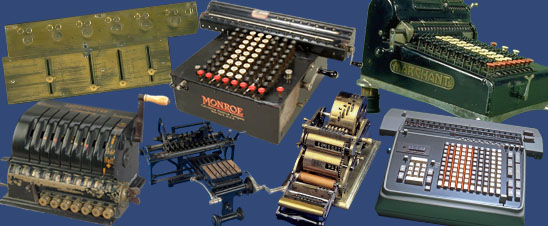This full-keyboard manually operated non-printing modified stepped drum calculating machine is a Monroe Model K, especially altered for use by the blind. It was owned by Russell Kletzing of Sacramento, Calif., a lawyer blinded as a child.
- Description
-
This full-keyboard manually operated non-printing modified stepped drum calculating machine is a Monroe Model K, especially altered for use by the blind. It was owned by Russell Kletzing of Sacramento, Calif., a lawyer blinded as a child. Kletzing was active in the National Federation of the Blind, and challenged the view that the U.S. Civil Service register should exclude blind lawyers because they could not read conventionally printed text.
-
The machine has a metal frame painted black, with rounded corners. The steel plate under the keyboard is painted green. The eight columnsof plastic keys are colored black or white accoding to the place value of the digit represented. The “5” digit keys have a raised metal dot on them. Key stems for clearance keys are at the bottom of each column, but have no key tops. Rods between the rows of keys to serve as decimal markers are lacking. Three keys in a column to the right of the number keys include one that clears the entire keyboard, with the other two set to determine whether or not the keyboard clears after each calculation. A metal lever is to the right of the keyboard and a metal knob to the left. The operating crank on the right side rotates clockwise for addition and counterclockwise for subtraction.
-
Behind the keyboard is a carriage that has a row of 16 numeral dials for recording results and a row of eight numeral dials behind for the revolution register. The revolution register dials are each numbered from 0 to 9 in black and from 1 to 9 in red. Fixed indentations between the revolution dials serve as decimal markers. Both of these sets of dials have digits in Braille as well as typeface. The carriage has no sliding decimal markers. Small paper stickers have been glued below the usual position of the decimal point and the thousands marker in the result register. The carriage shift lever is at the front of the machine. The carriage has a knob for lifting it to the right of the result register, and a crank for zeroing dials on its right side. The machine has four rubber feet.
-
A mark scratched on the back of the machine reads: Z265520. A mark on the right side of the mechanism, under the carriage, reads: Z97700. A mark on the bottom edge of the carriage at the left reads: 97700. A mark on the back of the machine, which has been painted over, reads: MONROE.
-
Compare to MA.334711 and MA.307386.
-
References:
-
J. H. McCarthy, American Digest of Business Machines, 1924, pp. 80–82, 551.
-
National Federation of the Blind, "NFB Awards 2000," Braille Monitor, August / September 2000.
- Location
-
Currently not on view
- date made
-
ca 1928
- maker
-
Monroe Calculating Machine Company
- ID Number
-
1983.0831.01
- maker number
-
Z97700
- accession number
-
1983.0831
- catalog number
-
1983.0831.01
